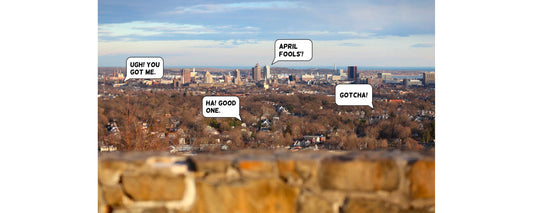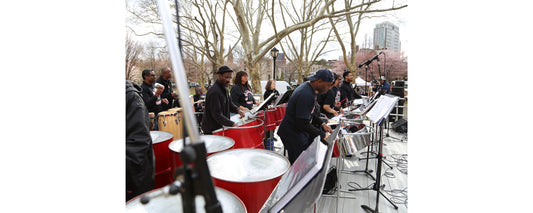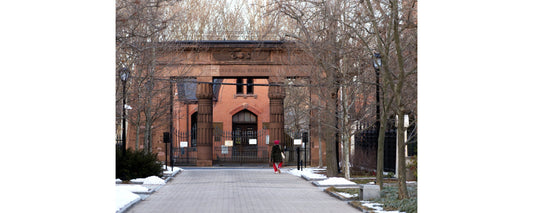Few buildings in New Haven have stirred more sentiment—positive or negative—than the New Haven Veterans Memorial Coliseum. Take, for example, the fact that 15 years after its demolition, a private Facebook group called New Haven Coliseum RIP has roughly 3,000 members and still gets posts. Or the fact that city leaders agonized for more than two decades over the cost of maintaining the structurally flawed building and brought a lawsuit against its architect.
The Coliseum, which opened in 1972, hosted basketball games, roller derbies, circuses, the Ice Capades and WWE wrestling. It was home to New Haven hockey teams: the Nighthawks, the Senators, the Beast and finally the Knights. But it may be remembered best as the place where many New Haveners experienced the most memorable concerts of their lives. The list of acts that played the Coliseum reads like a Who’s Who of the 1970s, ’80s and ’90s, from the older acts that originally dominated the bills—Lawrence Welk, Frank Sinatra—to the eventual takeover of rock, heavy metal, punk and rap despite the city’s early efforts to keep them out.
sponsored by
“[W]hile I am Mayor there will be no rock and roll melees in this city,” wrote Mayor Richard Lee after a post-concert riot in Boston in 1958. The Coliseum had yet to be built under Lee’s urban renewal plan, but the smaller New Haven Arena had plans to host a rock show with promoter Alan Freed. Lee canceled the concert, and the anti-rock and roll sentiment of city leaders lingered into the 1970s, until the “melees” could no longer be avoided.
From Sonny and Cher to Gwen Stefani, Bob Dylan to Puff Daddy, the Coliseum’s list of performers evolved with the decades. The venue hosted the biggest acts of its era: Bruce Springsteen, Elton John, Billy Joel, Queen, the Grateful Dead, David Bowie, the Beach Boys. An August 1986 Van Halen date was recorded at the Coliseum and released as the concert video Live Without a Net.
Even those who never saw a concert there knew the impossible-to-miss Brutalist behemoth, which sat at the edge of the Oak Street Connector. In order to deal with a small footprint and a high water table, architect Kevin Roche put the four-level parking garage on the top of the building, which required giant cylindrical parking ramps that some drivers found too scary to navigate. From the start, Roche’s design was controversial, and budgetary constraints forced him to remove elements that would have made the Coliseum more visually appealing, such as tile work to match the nearby Knights of Columbus tower, which he had also designed, and translucent panels around the garage that would have been lit at night and given the decks a sense of “floating” above the building.
But concertgoers and sports fans didn’t much mind exposed ductwork on the ceiling or lament the exhibition hall that was never built. They loved the Coliseum for what happened there, from the campouts to wait for tickets to go on sale to the fights during hockey games. New Haven club owner and concert promoter Fernando Pinto recalls a Kiss concert in the late 1970s, when he sat near the ceiling in a cloud of smoke that had drifted up from the floor below. “I had never seen that kind of wildness, you know?” Pinto says. “The place was sold out, so there was this incredible loudness, musically and in the audience.”
With its cement pillars and walls, the Coliseum was known to have terrible acoustics. Local musician Stephen Peter Rodgers—better known as Steve Rodgers, formerly of Mighty Purple and founder of music venue The Space and its spinoffs—recalls playing at the Coliseum during a 2002 Ralph Nader rally. The experience of sharing the stage with Patti Smith that day—a stage where Rodgers had seen “so many of my musical heroes” perform—was memorable, but the sound quality of the space was less thrilling. “I was not a fan of the acoustics, I have to be honest. I just remember it being really loud and boomy,” Rodgers says, adding humbly that maybe the audience was just too small to soak up the sound.
Hockey games were really loud, too. The stadium’s infamous Section 14 was the site of a fan base known to heckle visiting teams and wind up the crowd. “Welcome to the Jungle” read their black and white T-shirts, a reference to a Guns N’ Roses song. The “mosh pit intensity” of Section 14, as the film Last Days of the Coliseum (2010) calls it, energized some fans—especially through the 1989 American Hockey League playoffs, when the Nighthawks reached the finals—but repelled others with its profanity and poor sportsmanship.
The Coliseum hosted other events as well. Writer Franz Douskey spins the tale of a Mickey Mantle appearance in the mid-1980s, when the baseball legend was supposed to be signing bats and balls for $25 and up. Instead, he started signing balls for free and tossing them to kids, to the dismay of promoters. By closing time, Douskey writes, “he was signing anything and everything people handed him: shirts, jackets, dollar bills, eye glasses, underwear, and Mickey didn’t care as long as the Sharpies worked.” The balls he signed that day would be worth $500 or more today, Douskey estimates.
For all its colorful appeal, the Coliseum caused problems from the beginning. Oversized and underbuilt, it literally cast a permanent shadow over the neighborhood and served as a further barrier between downtown and neighborhoods to the south. Within its first decade, the building began to shed concrete, the result of road salt eating through its garage decks and weakening the steel below. The city hung netting to catch the falling chunks, and then-mayor John Daniels convinced the state to spend $23 million to repair the deteriorating garage, according to Last Days.
At the same time, the venue floundered against its competition: the Oakdale Theatre in Wallingford, the Hartford Civic Center (now XL Center) and later the Arena at Harbor Yard (now Total Mortgage Arena) in Bridgeport. With just over 11,000 seats, it was too big for small acts and too small for big ones. And it was only in use about one-third of the time, a problem architect Roche had anticipated. His original plan had called for “a symphony hall, theater and a restaurant to sustain vitality in the neighborhood,” Last Days notes. “Mayor Lee declined and asked Roche to return to his drawing table.”
In the end, the hulking venue lasted only 30 years. Mayor John DeStefano ordered it closed in 2002, prompting some preservationist resistance. Its final event, held in August of that year, was a professional wrestling show. Then the building sat vacant for three years while the city and state negotiated over who would pay to tear it down. It took another 18 months to remove the seats, the walls and other components. Finally, on the morning of January 20, 2007, about 20,000 people watched, many of them from the Temple Street Parking Garage, as the building was imploded, and a massive cloud of smoke and dust rose up and drifted out to sea. The building’s footprint is, for now, a parking lot.
On Facebook, members of New Haven Coliseum RIP share photos of concerts, ticket stubs, posters and versions of the exclamation, “I was there!” Admin Dan Santoro has frequently posted “on this date in New Haven concert history” updates, such as a ticket and backstage pass recalling a double bill of Blue Oyster Cult with Black Sabbath on September 19, 1980. In an interview in Last Days, Santoro summed up New Haven’s love-hate relationship with its largest entertainment venue: “The Coliseum was absolutely one of the worst places possible to see a show, … but we loved it. It was our home.”
Written by Kathy Leonard Czepiel. Images provided courtesy of the New Haven Museum. This updated story was originally published on September 23, 2020.








